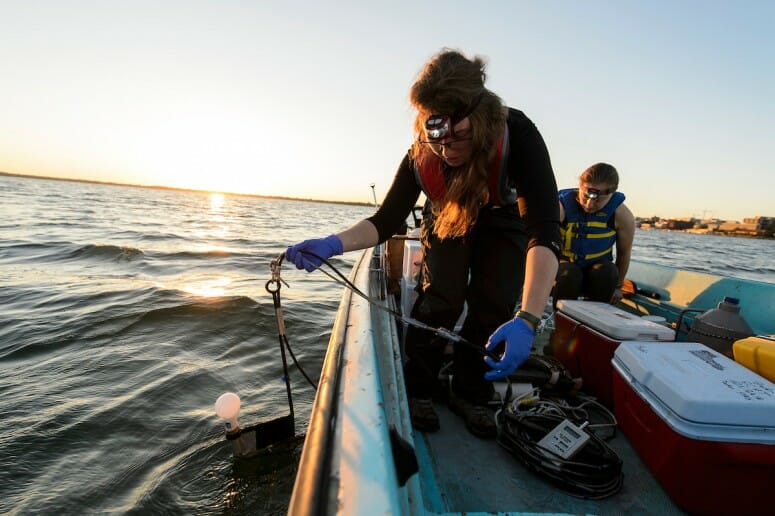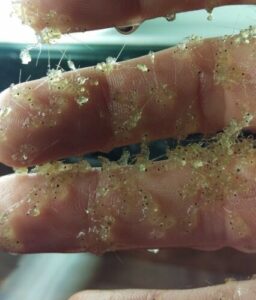
Students collect data and water samples from Lake Mendota during an early morning outing in 2016 for a limnology experiment. Limnology researchers discovered the spiny water flea in Lake Mendota in 2009. PHOTO: JEFF MILLER
When an invasive species overruns a new ecosystem, it is often assumed that the invader recently arrived at its new home and rapidly took over. But a new report in the journal BioScience finds that many new arrivals aren’t nearly as impatient as this narrative implies.
In fact, the study shows, it is not uncommon for “sleeper populations” of nonnative species to spend years or even decades persisting at such low population levels that they go undetected, only making their presence known once their numbers explode.
While current efforts are focused on stopping the spread of nonnative species to new habitats, it’s crucial that we also better understand what makes a species invasive in the first place. This means not just identifying species with a proclivity for overrunning ecosystems, but identifying the characteristics of an ecosystem that may set the stage for an invasion, he says.

Center for Limnology graduate student Vince Butitta’s hand covered in invasive spiny water fleas from Lake Mendota (Vince Butitta) PHOTO COURTESY OF VINCE BUTITTA
The finding has important implications for the way we approach invasive species control and management, says Jake Vander Zanden, director of the University of Wisconsin–Madison’s Center for Limnology and a co-author of the paper.
Nonnative species can occur as small, self-sustaining populations “smoldering like embers” in a new habitat, Vander Zanden says. Many will continue on with that modest life history, never having the negative ecological impacts that attract the invasive label. But, sometimes, an environmental trigger gets switched and the embers of these sleeper populations are fanned into a five-alarm fire.
One such invasion was the spiny water flea in Lake Mendota, just off the UW–Madison campus. In 2009, UW–Madison undergraduates on a lab field trip pulled in their nets and discovered thousands upon thousands of this tiny crustacean, which had never before been seen in the lake.
Scientists had previously predicted that the lake would be unsuitable for this cold-water species originally from European and Asian lakes. Center for Limnology researchers working in the North Temperate Lakes, a research site of the U.S. Long Term Ecological Research Network, had conducted more than two hundred sampling trips spanning three decades, yet they hadn’t turned up a single spiny water flea.
“It’s quite possible that the spiny water flea is established in lots of other lakes,” says Vander Zanden. “Currently, invasive species management is aimed at minimizing spread, but what if they’re already there? What if, instead, management practices were aimed at not setting off that trigger that would make populations explode?”

Jake Vander Zanden PHOTO: BRYCE RICHTER
But when researchers dug into Lake Mendota sediment cores and combed through old samples in the UW–Madison Zoological Museum, they discovered evidence of spiny water fleas dating back at least 10 years before their sudden population increase in 2009.
For their study, Vander Zanden and his colleagues highlighted what they call environmental triggers that have led to invasive species events in the past.
For example, humans brought cattle to Santa Cruz Island off the coast of California in the late 1800s. The cattle, in turn, tracked seeds of a nonnative fennel plant in with them. That plant got established on the island but was held in check by the grazing cattle. Once the cattle were removed from this new food web nearly a century later, the fennel took over.
In other parts of the world, climate change is triggering invasions, allowing long-simmering populations of rodents and weeds to thrive in ecosystems that had previously been too cold.
For the spiny water flea invasion of Lake Mendota, one abnormally cold summer was all it took for the sleeper population to take off. That summer, water temperatures in the lake hovered within a range similar to what the spiny water flea prefers in its native habitat. That resulted in billions of spiny water fleas thriving in the lake — and laying eggs for the next year. The invaders have been prominent ever since.
Understanding the environmental triggers that set a species on the path to invasion is crucial, says Mike Spear, lead author of the paper and a postdoctoral researcher at the University of Illinois and Illinois Natural History Survey.
“We are living in an era defined by environmental change. So, if environmental change is the trigger for them to explode and become super abundant and harmful to the ecosystem, then we’ve got a pretty big problem on our hands,” he says.
Finding these sleeper populations is also a challenge. Fortunately, says Spear, there are promising advancements in scientific methods. These new methods include analyzing water samples for the environmental DNA, or eDNA, that species shed into their habitats. As an example, researchers were able to collect water samples and detect eDNA from the invasive Asian carp in a Chicago waterway after only a single day of work. By comparison, traditional electrofishing methods took 93 days to find a carp.
The report also highlights how crucial long-term research is to documenting invasion dynamics and placing the story of an invasion in context. Without the North Temperate Lakes study’s decades of samples from Lake Mendota, for example, assumptions that the spiny water flea was a brand new invader would have persisted. Instead, researchers were able to comb through an ecological archive to get the full story.
Spear says that the paper asks a lot more questions than it answers. But he hopes that it can help people realize that detection of a nonnative species in an ecosystem doesn’t mean that it only recently arrived and, more importantly, doesn’t mean that a destabilizing invasion is imminent.
“What we’re trying to focus on are the external environmental factors that could trigger an outbreak and what implications that has for how we study and manage invasive species,” he says. “This paper argues for placing a real emphasis on finding where nonnative populations are, and where they are at low levels, because that’s really our only chance of preventing the damage before it happens.”
This work was supported in part by the National Science Foundation North Temperate Lakes Long Term Ecological Research Program (grant no. DEB‐1440297) and the U.S. Geological Survey Upper Midwest Environmental Sciences Center.
